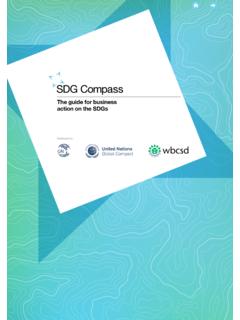Transcription of The guide for business action on the SDGs - SDG Compass
1 The guide for business action on the SDGsTMDeveloped by:Our planet faces massive economic, social and environmental combat these, the sustainable Development Goals (SDGs) define global priorities and aspirations for 2030. They represent an unprecedented opportunity to eliminate extreme poverty and put the world on a sustainable worldwide have already agreed to these goals. Now it is time for business to take SDG Compass explains how the SDGs affect your business offering you the tools and knowledge to put sustainability at the heart of your sustainable Development Goals (SDGs) PageStep 01 Understanding the SDGsStep 02 Defining prioritiesStep 03 Setting goalsStep 04 IntegratingStep 05 Reporting and communicating6 What are the SDGs? 7 Understanding the business case8 The baseline responsibilities for business10 Why do the SDGs matter for business ?
2 4 What is the SDG Compass ?511 Map the value chain to identify impact areas12 Select indicators and collect data14 Define priorities1516 Define scope of goals and select KPIs17 Define baseline and select goal type18 Set level of ambition18 Announce commitment to SDGs2025 Effective reporting and communication27 Communicating on SDG performance2821 Anchoring sustainability goals within the business22 Embed sustainability across all functions23 Engage in partnerships24 Executive summary3 SDG s inside?Why do the SDGs matter for business ?4 SDG summaryThe sustainable Development Goals (SDGs) define global sustainable development priorities and aspirations for 2030 and seek to mobilize global efforts around a common set of goals and targets. The SDGs call for worldwide action among governments, business and civil society to end poverty and create a life of dignity and opportunity for all, within the boundaries of the their predecessor, the Millennium Development Goals, the SDGs explicitly call on all businesses to apply their creativity and innovation to solve sustainable development challenges.
3 The SDGs have been agreed by all governments, yet their success relies heavily on action and collaboration by all SDGs present an opportunity for business -led solutions and technologies to be developed and implemented to address the world s biggest sustainable development the SDGs form the global agenda for the development of our societies, they will allow leading companies to demonstrate how their business helps to advance sustainable development, both by minimizing negative impacts and maximizing positive impacts on people and the planet. Covering a wide spectrum of sustainable development topics relevant to companies such as poverty, health, education, climate change and environmental degradation the SDGs can help to connect business strategies with global priorities. Companies can use the SDGs as an overarching framework to shape, steer, communicate and report their strategies, goals and activities, allowing them to capitalize on a range of benefits such as: Identifying future business opportunities The SDGs aim to redirect global public and private investment flows towards the challenges they represent.
4 In doing so they define growing markets for companies that can deliver innovative solutions and transformative change. Enhancing the value of corporate sustainability Whilst the business case for corporate sustainability is already well established, the SDGs may for example strengthen the economic incentives for companies to use resources more efficiently, or to switch to more sustainable alternatives, as externalities become increasingly internalized. Strengthening stakeholder relations and keeping the pace with policy developments The SDGs reflect stakeholder expectations as well as future policy direction at the international, national and regional levels. Companies that align their priorities with the SDGs can strengthen engagement of customers, employees and other stakeholders, and those that don t will be exposed to growing legal and reputational risks.
5 Stabilizing societies and markets business cannot succeed in societies that fail. Investing in the achievement of the SDGs supports pillars of business success, including the existence of rules-based markets, transparent financial systems, and non-corrupt and well-governed institutions. Using a common language and shared purpose The SDGs define a common framework of action and language that will help companies communicate more consistently and effectively with stakeholders about their impact and performance. The goals will help bring together synergistic partners to address the world s most urgent societal challenges. business is a vital partner in achieving the sustainable Development Goals. Companies can contribute through their core activities, and we ask companies everywhere to assess their impact, set ambitious goals and communicate transparently about the Ki-moon, United Nations Secretary-General5 SDG objective of the SDG Compass is to guide companies on how they can align their strategies as well as measure and manage their contribution to the guide presents five steps that assist companies in maximizing their contribution to the SDGs.
6 Companies can apply the five steps to set or align their course, depending on where they are on the journey of ensuring that sustainability is an outcome of core business five steps of the SDG Compass rest on the recognition of the responsibility of all companies to comply with all relevant legislation, respect international minimum standards and address as a priority all negative human rights SDG Compass is developed with a focus on large multinational enterprises. Small and medium enterprises and other organizations are also encouraged to use it as a source of inspiration and adapt as necessary. It is also designed for use at entity level, but may be applied at product, site, divisional or regional level as required. The SDG Compass guide is organized into sections that address each of the five steps of the guide :01 Understanding the SDGs As a first step, companies are assisted in familiarizing themselves with the SDGs.
7 02 Defining priorities To seize the most important business opportunities presented by the SDGs and reduce risks, companies are encouraged to define their priorities based on an assessment of their positive and negative, current and potential impact on the SDGs across their value chains. 03 Setting goals Goal setting is critical to business success and helps foster shared priorities and better performance across the organization. By aligning company goals with the SDGs, the leadership can demonstrate its commitment to sustainable development. 04 Integrating Integrating sustainability into the core business and governance, and embedding sustainable development targets across all functions within the company, is key to achieving set goals. To pursue shared objectives or address systemic challenges, companies increasingly engage in partnerships across the value chain, within their sector or with governments and civil society organizations.
8 05 Reporting and communicating The SDGs enable companies to report information on sustainable development performance using common indicators and a shared set of priorities. The SDG Compass encourages companies to build the SDGs into their communication and reporting with is the SDG Compass ?Step 01 Understanding the SDGs6 SDG SDGs call on companies everywhere to advance sustainable development through the investments they make, the solutions they develop, and the business practices they adopt. In doing so, the goals encourage companies to reduce their negative impacts while enhancing their positive contribution to the sustainable development agenda. The degree and speed with which companies around the world develop more sustainable and inclusive business models will play a large role in the success of achieving the SDGs. In turn, all companies are impacted by the challenges that the SDGs address.
9 In this step we will explore what the SDGs are, how they came about, how companies can use them to their benefit, and how they build on existing business responsibilities by covering the following areas: What are the SDGs? 7 Understanding the business case 8 The baseline responsibilities for business 10As a first step, it s important to familiarize yourself with the SDGs and understand the opportunities and responsibilities they represent to your goal offers several specific and actionable targets. To find out more visit: for global action : Between 2000 and 2015, the Millennium Development Goals (MDGs) provided an important development framework and achieved success in a number of areas such as reducing poverty and improving health and education in developing SDGs succeed the MDGs, expanding the challenges that must be addressed to eliminate poverty and embracing a wide range of inter-connected topics across the economic, social and environmental dimensions of sustainable SDGs were born out of what is arguably the most inclusive process in the history of the United Nations, reflecting substantive input from all sectors of society and all parts of the world.
10 Through the UN Global Compact alone, more than 1,500 companies provided input and goals are universally applicable in developing and developed countries alike. Governments are expected to translate them into national action plans, policies and initiatives, reflecting the different realities and capacities their countries they primarily target governments, the SDGs are designed to rally a wide range of organizations, and shape priorities and aspirations for sustainable development efforts around a common framework. Most importantly, the SDGs recognize the key role that business can and must play in achieving 1 End poverty in all its forms everywhere Goal 2 End hunger, achieve food security and improved nutrition and promote sustainable agricultureGoal 3 Ensure healthy lives and promote well-being for all at all agesGoal 4 Ensure inclusive and equitable quality education and promote lifelong learning opportunities for allGoal 5 Achieve gender equality and empower all women and girlsGoal 6 Ensure availability and sustainable management of water and sanitation for allGoal 7 Ensure access to affordable, reliable, sustainable and modern energy for allGoal 8 Promote sustained, inclusive and sustainable economic growth, full and productive employment and decent work for allGoal 9 Build resilient infrastructure.





